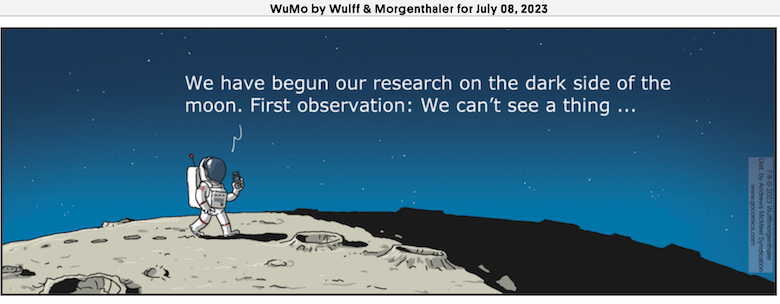This comic illustrates a common misconception, that there is a side of the Moon that is in permanent darkness.
(WuMo)
In reality, as the Moon orbits the Earth, any hemisphere (‘side’) experiences equal amounts of sunlight and darkness, just like the Earth. What is true is that due to tidal forces caused by the Earth, the Moon is ‘locked’ with the Earth so that only one side faces the Earth at all times. As a result, it experiences cycles of two weeks of sunlight and two weeks of darkness as it orbits the Earth.
So while there is no dark side, there is such a thing as the ‘far side’ of the Moon that we cannot see from the Earth. The USSR space probe Luna 3 was the first to photograph the far side in 1959.
I am not sure when the notion that the Moon has a permanent dark side originated. Historically, the ‘dark side of the Moon’ was used colloquially (and correctly) to mean ‘hidden’ or ‘unseen’ but at some point became popularly associated with ‘unlit’. That idea may have gained popularity from the massive success of the 1973 Pink Floyd album The Dark Side of the Moon, although this was an allusion to lunacy and has nothing to do with astronomy.


It’s mind blowing the first time anyone sees those far side photos, the surface completely pock marked with impact craters instead of the “seas” we look at. Another strange effect that occurs once or twice a year at higher lattitudes (50+° north or south) is seeing a near full moon during the daytime.
Does Sri Lanka have the same pareidolia, seeing a “man in the moon”, or something else? I’ve never gotten used to the East Asia pareidolia, where they call it “the rabbit in the moon”.
The Dark Side of the Moon. I listened to the entire album just yesterday. I feel more detached from the disconnection of the album, but I understand the nuances and references much better.
And, yeah, the dark side of the moon. I remember that discussion in Advanced Biology back during my second junior year of high school.
I’m still pissed that NASA and the Soviets are still covering up the giant monolithic rectangle parked there . . .
Intransitive,
I cannot speak for other Sri Lankans but as for me, I always saw the rabbit.
Patterns seen in the near side markings of the moon include a face, a skull, a lady reading a book, a rabbit and a beetle.
In other words it does have a dark side. Usage of ‘dark’ to mean hidden, unknown, little information etc. is not obscure -- even low-brow action movies use it when the heroes lose communication with some place -- “Squad three has gone dark” or whatever, to mean loss of communication.
Holms, https://en.wikipedia.org/wiki/The_Dark_Side_of_the_Sun
I saw the man in the moon first mainly because of The Honeymooners but I can also see the rabbit . Once my grandmother made it clear that we had American Indian ancestry I look for the rabbit after seeing the man in the moon ! I was about 10 when I realized that the moon showed up in the daytime . Then promptly got into an argument with my little sister’s best friend about that being the actual moon.
The dark side of the moon is from the cheese going bad.🌚
The album ends with the spoken words, “There is no dark side of the moon really -- matter of fact it’s all dark.”
Which is true! I’ve seen actual lunar regolith (moon soil) and it’s a surprisingly dark grey, like crushed charcoal.
Scientifically, albedo is a measure of how much light a body reflects, with 0 (or 0%) meaning no light reflected, and 1 (or 100%) being a perfect reflector. The albedo of the moon is very low at about 11%. Here’s a comparison with other solar system bodies.
I’ve never understood how Americans see a man in the moon, when you’re looking at it the wrong way up!
Here’s a picture for comparison.
Here in the more civilized hemisphere we can see some sort of a face, with a gaping mouth to the lower left. And now that you mention it, the markings do look a bit like a bunny rabbit.
But yours doesn’t look like anything because it’s upside down. 😉
The last song on the LP is ‘Eclipse’ -- so the Moon is indeed all dark.
And the light side is on average darker than the dark side, because lunar eclipses happen only on the light side.
That solar eclipses exist sorta has to mean it’s not always dark.
@11: I suspect that the albedo differences between the near and far sides of the moon have a larger effect on the average brightness than eclipses. As the maria have lower albedo (are darker than) the highlands the effect is the same; the near side is on average darker than the far side.
Silentbob@9:
And now I’ve got a voice saying ‘Albedo zero point three nine’ in my head, thanks.
(Vangelis had a 1976 album ‘Albedo 0.39’, and the title track had a voice reciting astronomical facts about the Earth over the music, ending with ‘Albedo zero point three nine’ repeated a couple of times. Unsurprisingly, tracks from that album were used for the original Cosmos miniseries.)
I can’t help but recall the scene from the 1953 cheesy sci-fi, ‘Cat Women of the Moon’ where Sonny Tufts stops his fellow lunar explorers at the terminator (their rocket having landed on the dark side). He asks for a cigarette which he then tosses into the sunlit hemisphere. The cigarette instantaneously combusts!
😉
@jenorafeuer -- and now I have that exact same voice in my head, thanks for that. Haven’t heard that album since about 1986, I’m going to have to dig it out now…